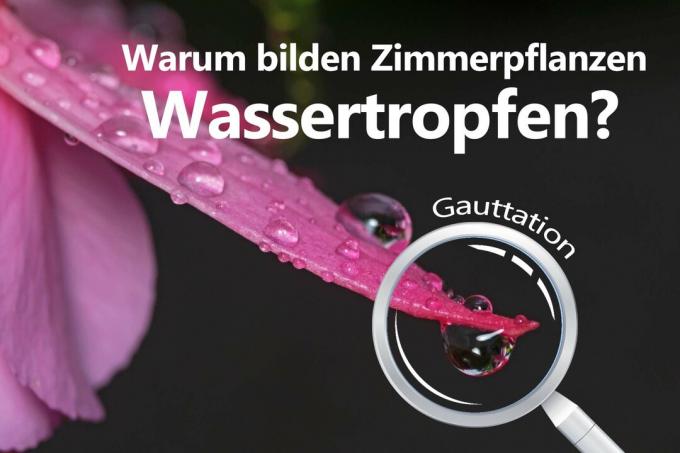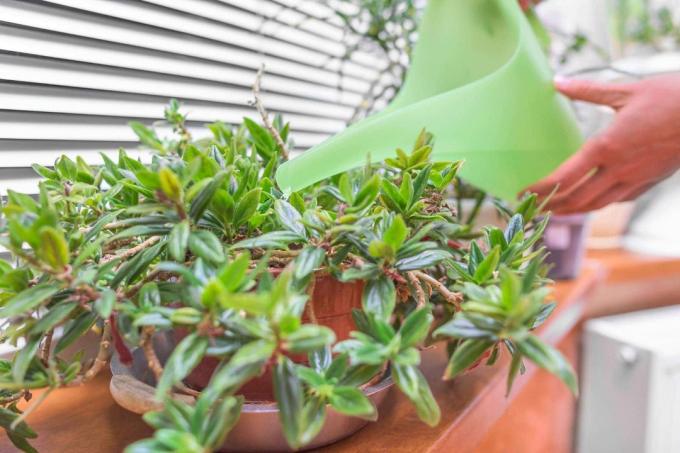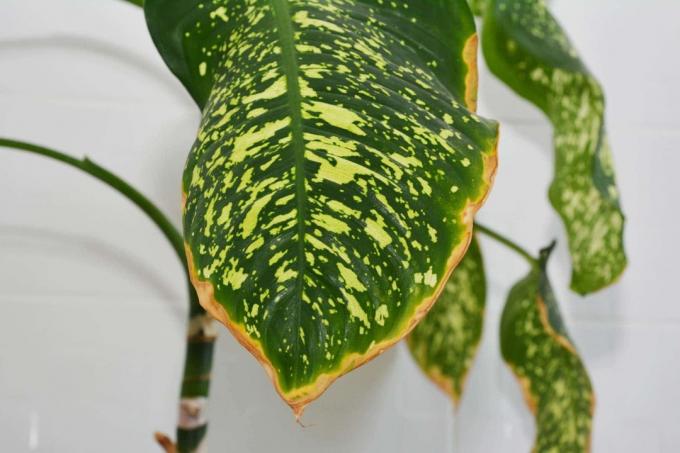
Table of Contents
- definition
- functionality
- Affected plant species
- difference from dewdrops
- dew surface
- taste
- risk of guttation
- Yellow leaves
- frequently asked Questions
Guttation is a natural process induced by the plant system under certain circumstances. How the water droplets form on indoor plants and how watering is related to this can be found below.
In a nutshell
- Guttation easily confused with dew water droplets
- Drop production always at night
- serves for self-protection by means of water regulation
definition
Guttation is a type of water balance that occurs automatically with certain houseplants. These mainly include those with a thinner epidermis (skin). Here, the evaporation of water is much more intensive than, for example, cacti with a thick skin and wax layer. However, if the moisture content in the soil is so high that there is excess water despite evaporation, affected indoor plants "sweat" it and form water droplets.

functionality
Guttation usually occurs at night when darkness prevents photosynthesis and evaporation from sunlight. In addition, high humidity promotes sweating if the damp soil also has a higher temperature than the surrounding area. The damp soil gains weight, the pressure on the roots increases and this automatically pushes the moisture into the leaves. There it escapes through the glandular cells at the edge of the leaf, where water droplets form and fall off.
Affected plant species
In principle, all plants that allow relatively high evaporation due to permeable skin and thus also allow the formation of water droplets can be affected. But there are some houseplants in particular where guttation drops occur particularly frequently. These include:
- tree friend (Philodendron)
- Dieffenbachia (Dieffenbachia)
- window leaf (Monstera)
- Fuchsias (Fuchsia)
- lucky feather (Zamioculcas zamiifolia)
- arrow leaves (Alocasia)

difference from dewdrops
Unlike guttation, water droplets from dew do not form as a result of a natural reaction of plants. They are caused by purely external influences. The dropping nighttime temperatures lead to condensation of the water in the air. The water vapor liquefies. The water settles everywhere, including on the plants.
dew surface
Dew drops are not limited to the leaves or leaf edges. They can also be found on the stems and flowers. Because this requires a strong temperature difference from warm to cool, dew drops do not usually occur on houseplants in living areas. If there are water droplets on the leaf edges, it is always a matter of guttation.

taste
If you want to know exactly whether it is dew or guttation drops, you can do the taste test. To do this, it must be ensured in advance that the plant is not a poisonous specimen. If there are guttation drops, the water pressure can also force out plant sap. This one is with most poisonous plants the most toxic part. Dewdrops are absolutely tasteless. Guttation drops taste slightly sweet.
Notice: Even with non-toxic plants, a taste test should only be carried out if you are absolutely sure that there are no harmful substances in the substrate. These, too, can be found in the water droplets of the plant that forms them through the guttation process.
risk of guttation
Although indoor plants initiate water regulation through this automatic mechanism, the trigger is always excessive moisture in the soil.

In most cases, this is caused by excessive watering and/or poor drainage. Waterlogging is the result. This always represents an increased risk for every houseplant. In addition, "sweating" only works when the ambient temperature is higher than that of the earth. If this is not the case, serious plant damage such as rot and mold growth are not uncommon. Therefore, when guttation drops form:
- Water plants significantly less
- If necessary, cut back roots that are already soaked
- transplant into dry soil
- Avoid waterlogging in the future
Tip: As soon as the soil smells musty, the substrate should definitely be changed. Watering less is usually no longer enough to ensure healthy, vigorous growth of the houseplants.
Yellow leaves

If indoor plants form water droplets at night, this can lead to the development of yellow leaves. This is due to the lack of nutrients. This is progressively reduced the higher the pressure on the roots and consequently the water pressure in the plant parts.
frequently asked Questions
The key to preventing water droplets on plant leaves is to provide the right level of moisture. This mainly includes soil moisture. The rule is: it is better to water less, but more often. As long as you can easily push your thumb into the soil at least an inch, watering is not advisable. Only use planters with a drainage hole for excess water. A drainage of potsherds, gravel or quartz sand at the bottom of the pot is also recommended.
This makes sense if they would otherwise fall off into the ground. This allows the soil to be moistened (again), although the plant actually wants to reduce water through the guttation. Take a microfiber cloth or similar and gently wipe away the water on the leaves.
This means guttations. It's just a folksy description that's more common among home gardeners and plant lovers. Both terms are identical in definition and all other properties.


